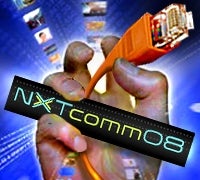 |
LAS VEGAS — AT&T (NYSE: T) is driving global prosperity. At least, that’s the thinking of Randall Stephenson, chairman and CEO of the country’s No. 1 wireless carrier, during his opening keynote here at the NXTcomm conference.
Stephenson, no stranger to NXTcomm after kicking off the show in Chicago last year, delivered a message today detailing the industry’s incredible growth potential and the opportunity for fixed and mobile networks to dramatically improve people’s lives.
But that sentiment comes against a backdrop of macroeconomic malaise in the United States, a rapidly changing telecom landscape thanks to growing demand for wireless data and furious competition among the country’s major wireless carriers.
And as traditional telecom providers fight tooth-and-nail with each other while also competing with cable ISPs and even pure-play Internet firms such as Google (NASDAQ: GOOG), a participant in the recent federal 700MHz wireless auction, the telecommunications world may be facing a crisis of identity.
“What business is it that we’re in?” Stephenson asked the audience. “We provide one thing — we provide velocity.”
“If we make businesses and governments and households run more efficiently and improve the entire experience, we accelerate commercial velocity and drive economic growth,” he said. “That translates into prosperity.”
He added that innovation around mobile connectivity will transform lives and grow economies around the globe.
To illustrate the rapid pace of wireless innovation, Stephenson pulled an iPhone 3G from his pocket and showed it off to the audience.
“It’s a perfect example of how innovation continues to accelerate,” Stephenson said of the 3G iPhone, which Apple (NASDAQ: AAPL) and AT&T debuted just last week.
“We’re doing things with technology today that would have been hard to imagine a few years ago,” he added. “Our devices will get smaller and smarter, and user interfaces will become more intuitive. No one in this room can predict what the future will bring.”
But innovation may not be the sole reason for unpredictability, with both AT&T and competitors such as Verizon Wireless seeking new ways to gain ground in their battle for market share.
In addition to teaming up once more with Apple to roll out the new 3G iPhone, AT&T has been making other moves to strengthen its hand. The company has been busy striking deals for its broadband services and grabbed a slice of the 700MHz spectrum in the recent wireless auction.
But archrival Verizon Wireless recently said it would acquire smaller player Alltel in a bid to nab AT&T’s lead spot in U.S. wireless subscribers.
The No. 2 carrier also has ambitious goals to expand its market presence through its recent multibillion-dollar win of the closely watched 700MHz C Block spectrum during the FCC auction and a higher-speed Long-Term Evolution network.
Despite turmoil in the market, Stephenson added that connectivity always has been the foundation for commercial and economic growth — and always will be.
Connectivity helped to determine where cities historically sprang up, initially around seaports and other places people congregated, he said.
“One thing that has provided more connectivity than everything else combined was the advent of the telephone,” Stephenson said. “With that, suddenly distance doesn’t matter anymore.”
Mobility is also a game-changer: Stephenson said that when you mobilize something, usage explodes.
“Mobility accelerates voice,” he said. “Voice minutes are growing on the AT&T network at 10 percent annually. Wireless data across our network is growing by 400 percent a year.”
Stephenson added that when you combine telephone, mobility, streaming video and the Internet, things get really exciting.
“As we connect more things and mobilize, we stimulate economic growth, and that drives prosperity,” Stephenson said.
Stephenson cited data from the London School of Economics that found that for every 10 new mobile phones per 100 people, a country’s Gross Domestic Product increases by 10 percent.
He added that 80 percent of the world’s population currently lives within range of a cellular network.
“Our business at AT&T is simple: We connect people to their world, and we do it on their terms,” Stephenson said. “Today, conservatively, more than 1 billion devices are connected to the AT&T network.”
Stephenson noted that the telecom industry is sitting on a world of potential, but to unlock it, vendors need to manage growing complexity in the ecosystem that has been developed. Every new product involves a lot of players, he said.
“It took a whole lot of companies to bring our IPTV platform to market,” Stephenson said. “The same thing with the iPhone — it took a lot of vendors to design and support it and now with the 3G iPhone, the ecosystem is even bigger.”
Stephenson warned the audience that opportunity is fleeting in the telecom business and there is no time for missed deadlines or products.
“These are exciting times to be in this business,” Stephenson said. “We’re on the verge of an innovation explosion.”


